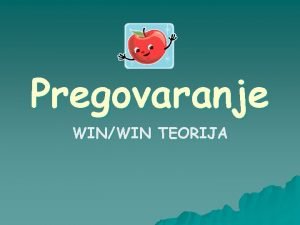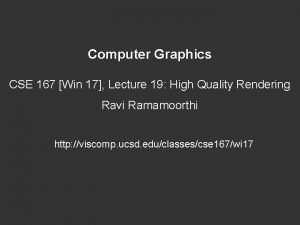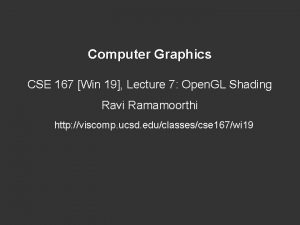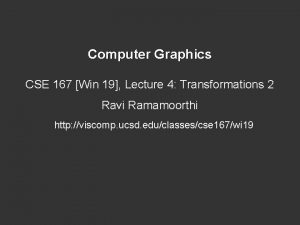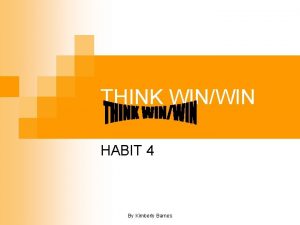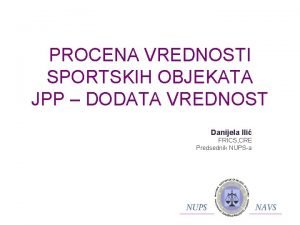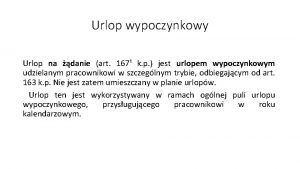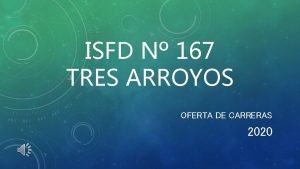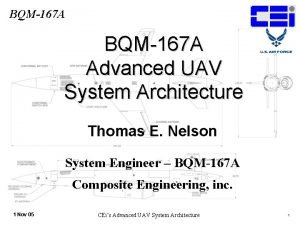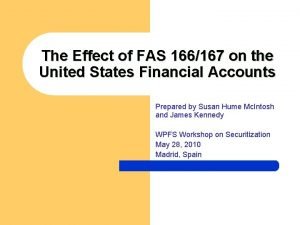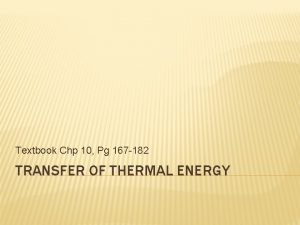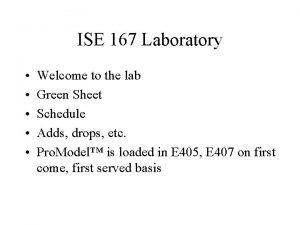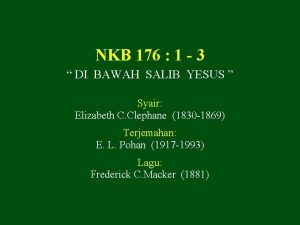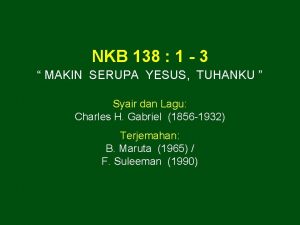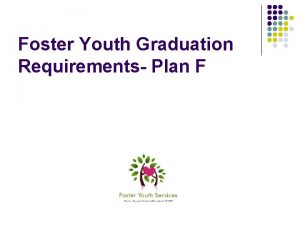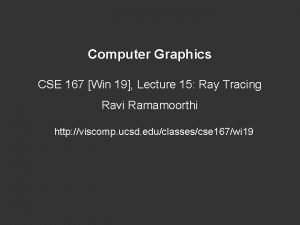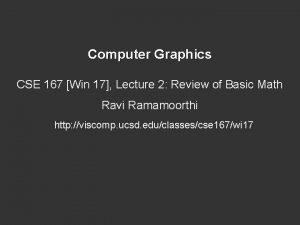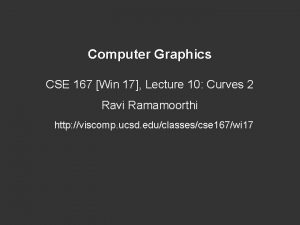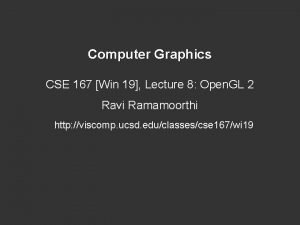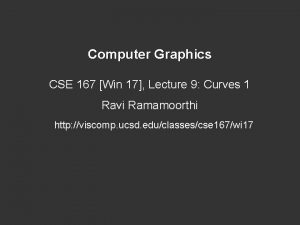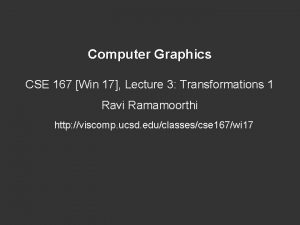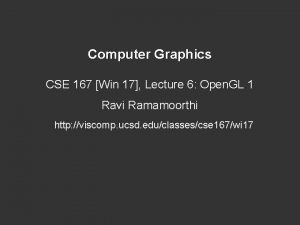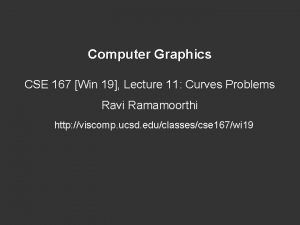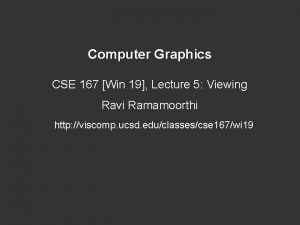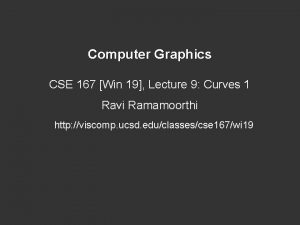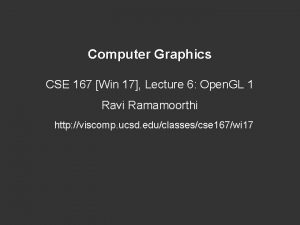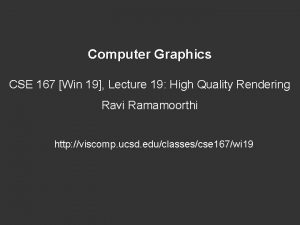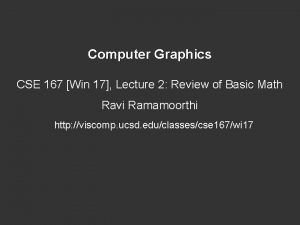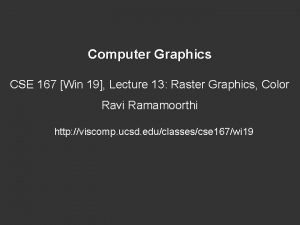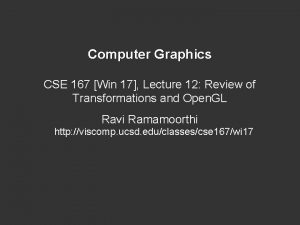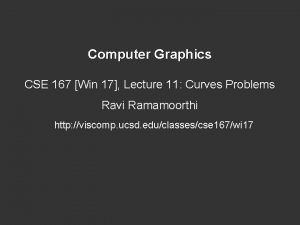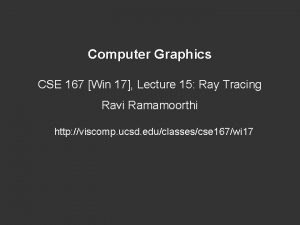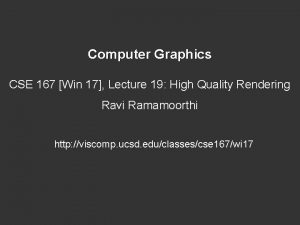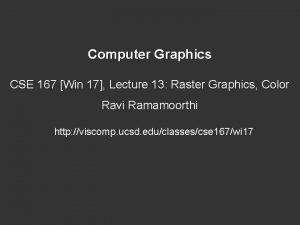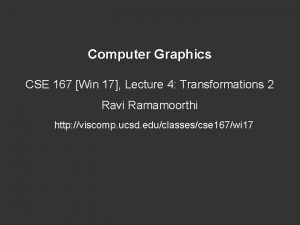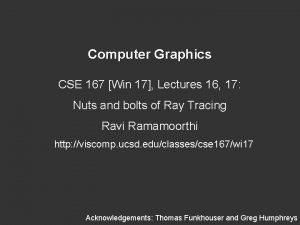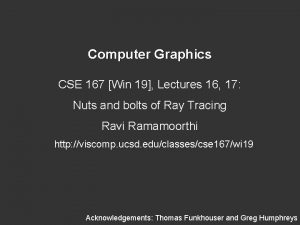Computer Graphics CSE 167 Win 19 Lecture 4
![Computer Graphics CSE 167 [Win 19], Lecture 4: Transformations 2 Ravi Ramamoorthi http: //viscomp. Computer Graphics CSE 167 [Win 19], Lecture 4: Transformations 2 Ravi Ramamoorthi http: //viscomp.](https://slidetodoc.com/presentation_image/acdcfdae92fc73b6815ee4fbbdf62123/image-1.jpg)



































- Slides: 36
![Computer Graphics CSE 167 Win 19 Lecture 4 Transformations 2 Ravi Ramamoorthi http viscomp Computer Graphics CSE 167 [Win 19], Lecture 4: Transformations 2 Ravi Ramamoorthi http: //viscomp.](https://slidetodoc.com/presentation_image/acdcfdae92fc73b6815ee4fbbdf62123/image-1.jpg)
Computer Graphics CSE 167 [Win 19], Lecture 4: Transformations 2 Ravi Ramamoorthi http: //viscomp. ucsd. edu/classes/cse 167/wi 19

To Do § Start doing HW 1 § Time is short, but needs only little code [Due Jan 23] § Ask questions or clear misunderstandings by next lecture § Specifics of HW 1 § Last lecture covered basic material on transformations in 2 D Likely need this lecture to understand full 3 D transformations § Last lecture had full derivation of 3 D rotations. You only need final formula § glu. Look. At derivation this lecture helps clarifying some ideas § Read and post on Piazza re questions § Any remaining issues with ed. X edge graders, submission of homeworks?

Outline § Translation: Homogeneous Coordinates § Combining Transforms: Scene Graphs § Transforming Normals § Rotations revisited: coordinate frames § glu. Look. At (quickly)

Translation § E. g. move x by +5 units, leave y, z unchanged § We need appropriate matrix. What is it? Transformations game demo

Homogeneous Coordinates § Add a fourth homogeneous coordinate (w=1) § 4 x 4 matrices very common in graphics, hardware § Last row always 0 0 0 1 (until next lecture)

Representation of Points (4 -Vectors) Homogeneous coordinates § Divide by 4 th coord (w) to get (inhomogeneous) point § Multiplication by w > 0, no effect § Assume w ≥ 0. For w > 0, normal finite point. For w = 0, point at infinity (used for vectors to stop translation)

Advantages of Homogeneous Coords § Unified framework for translation, viewing, rot… § Can concatenate any set of transforms to 4 x 4 matrix § No division (as for perspective viewing) till end § Simpler formulas, no special cases § Standard in graphics software, hardware

General Translation Matrix

Combining Translations, Rotations § Order matters!! TR is not the same as RT (demo) § General form for rigid body transforms § We show rotation first, then translation (commonly used to position objects) on next slide. Slide after that works it out the other way § Demos with applet, homework 1

Combining Translations, Rotations Transformations game demo

Combining Translations, Rotations Transformations game demo

Outline § Translation: Homogeneous Coordinates § Combining Transforms: Scene Graphs § Transforming Normals § Rotations revisited: coordinate frames § glu. Look. At (quickly) Slides for this part courtesy Prof. O’Brien

Hierarchical Scene Graph

Drawing a Scene Graph § Draw scene with pre-and-post-order traversal § Apply node, draw children, undo node if applicable § Nodes can carry out any function § Geometry, transforms, groups, color, … § Requires stack to “undo” post children § Transform stacks in Open. GL § Caching and instancing possible § Instances make it a DAG, not strictly a tree

Example Scene-Graphs

Outline § Translation: Homogeneous Coordinates § Combining Transforms: Scene Graphs § Transforming Normals § Rotations revisited: coordinate frames § glu. Look. At (quickly)

Normals § Important for many tasks in graphics like lighting § Do not transform like points e. g. shear § Algebra tricks to derive correct transform Incorrect to transform like points

Finding Normal Transformation

Outline § Translation: Homogeneous Coordinates § Combining Transforms: Scene Graphs § Transforming Normals § Rotations revisited: coordinate frames § glu. Look. At (quickly)

Coordinate Frames § All of discussion in terms of operating on points § But can also change coordinate system § Example, motion means either point moves backward, or coordinate system moves forward

Coordinate Frames: In general § Can differ both origin and orientation (e. g. 2 people) § One good example: World, camera coord frames (H 1) Camera World

Coordinate Frames: Rotations

Outline § Translation: Homogeneous Coordinates § Combining Transforms: Scene Graphs § Transforming Normals § Rotations revisited: coordinate frames § glu. Look. At (quickly)

Geometric Interpretation 3 D Rotations § Rows of matrix are 3 unit vectors of new coord frame § Can construct rotation matrix from 3 orthonormal vectors

Axis-Angle formula (summary)

Outline § Translation: Homogeneous Coordinates § Combining Transforms: Scene Graphs § Transforming Normals § Rotations revisited: coordinate frames § glu. Look. At (quickly)

Case Study: Derive glu. Look. At Defines camera, fundamental to how we view images § glu. Look. At(eyex, eyey, eyez, centerx, centery, centerz, upx, upy, upz) § Camera is at eye, looking at center, with the up direction being up Up vector Eye § May be important for HW 1 § Combines many concepts discussed in lecture § Core function in Open. GL for later assignments Center

Steps § glu. Look. At(eyex, eyey, eyez, centerx, centery, centerz, upx, upy, upz) § Camera is at eye, looking at center, with the up direction being up § First, create a coordinate frame for the camera § Define a rotation matrix § Apply appropriate translation for camera (eye) location

Constructing a coordinate frame? We want to associate w with a, and v with b § But a and b are neither orthogonal nor unit norm § And we also need to find u from lecture 2

Constructing a coordinate frame § We want to position camera at origin, looking down –Z dirn § Hence, vector a is given by eye – center § The vector b is simply the up vector Up vector Eye Center

Steps § glu. Look. At(eyex, eyey, eyez, centerx, centery, centerz, upx, upy, upz) § Camera is at eye, looking at center, with the up direction being up § First, create a coordinate frame for the camera § Define a rotation matrix § Apply appropriate translation for camera (eye) location

Geometric Interpretation 3 D Rotations § Rows of matrix are 3 unit vectors of new coord frame § Can construct rotation matrix from 3 orthonormal vectors

Steps § glu. Look. At(eyex, eyey, eyez, centerx, centery, centerz, upx, upy, upz) § Camera is at eye, looking at center, with the up direction being up § First, create a coordinate frame for the camera § Define a rotation matrix § Apply appropriate translation for camera (eye) location

Translation § glu. Look. At(eyex, eyey, eyez, centerx, centery, centerz, upx, upy, upz) § Camera is at eye, looking at center, with the up direction being up § Cannot apply translation after rotation § The translation must come first (to bring camera to origin) before the rotation is applied

Combining Translations, Rotations

glu. Look. At final form
 Lose-win the doormat
Lose-win the doormat Win win win lose lose lose
Win win win lose lose lose Win-win win-lose lose-lose
Win-win win-lose lose-lose Cse 167
Cse 167 Cse 167
Cse 167 Cse 167
Cse 167 Graphics monitors and workstations in computer graphics
Graphics monitors and workstations in computer graphics Introduction to computer graphics ppt
Introduction to computer graphics ppt Win-win negotiations are also known as
Win-win negotiations are also known as Win win situation examples
Win win situation examples Habit 4 think win-win examples
Habit 4 think win-win examples Think win-win
Think win-win Win win situation examples conflict resolution
Win win situation examples conflict resolution Boulwarism negotiation
Boulwarism negotiation Win win or no deal
Win win or no deal Win win nacin placanja
Win win nacin placanja Win win or no deal
Win win or no deal 01:640:244 lecture notes - lecture 15: plat, idah, farad
01:640:244 lecture notes - lecture 15: plat, idah, farad Urlop wypoczynkowy art 167
Urlop wypoczynkowy art 167 Lirik nkb 167
Lirik nkb 167 Instituto 167
Instituto 167 Bqm-167
Bqm-167 Dlpp-261
Dlpp-261 Fas 166/167
Fas 166/167 Pg 167
Pg 167 Hunger games chapter 17
Hunger games chapter 17 Lab 167
Lab 167 Eu 167/2013
Eu 167/2013 Di bawah salib yesus
Di bawah salib yesus Nkb 167
Nkb 167 Ab167 worksheet
Ab167 worksheet Computer security 161 cryptocurrency lecture
Computer security 161 cryptocurrency lecture Computer aided drug design lecture notes
Computer aided drug design lecture notes Architecture lecture notes
Architecture lecture notes Isa definition computer
Isa definition computer Angel computer graphics
Angel computer graphics Define viewing in computer graphics
Define viewing in computer graphics


